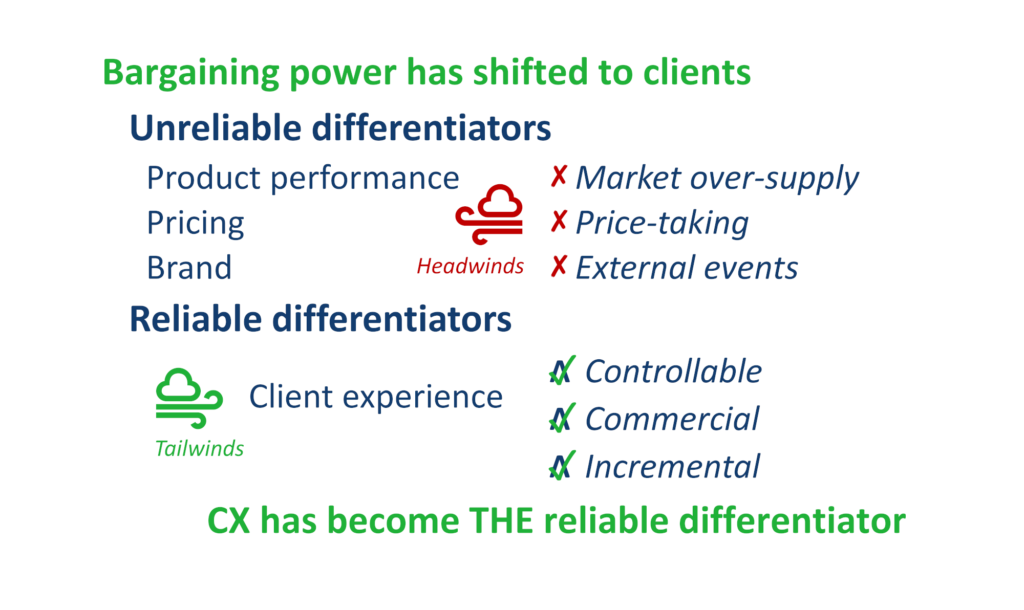Client experience has become the differentiator
Seize the opportunity to adapt

One minute briefing
- In key market sectors, multi-decade industry trends mean that for many asset managers client experience (CX) has become the way to get noticed and to retain their clients’ confidence.
- A deliberate CX will impact your profitability twice: increased revenue retention will protect gross profits, while minimising end-to-end complexity will manage costs and defend net profits.
- However, about 75% of firms lack a CX strategy and sufficient CX governance, and it is causing problems that span the client journey.
- This situation presents an opportunity to gain a competitive edge and, to seize it, firms should consider a four-stage response:
A CX response plan
Stage 4 – Embed
Safeguard the durability of your CX by embedding it into digital workflow and governance
Stage 3 – Design
Design a deliberate experience designed to meet the needs of your client base

Stage 2 – CX strategy
Choose a CX strategy – segment, customise, or standardise
Stage 1 – Assess your CX maturity
Ensure you only build on solid foundations by first assessing the maturity and sustainability of your current CX capability
Client experience has become the differentiator
In key market sectors, multi-decade industry trends mean that for many asset managers client experience (CX) has become the way to get noticed and to retain their clients’ confidence.
This situation presents an opportunity to gain a competitive edge
Executive summary
“When we pitch, we know our product and fees are no longer differentiators – our reputation for service is the decisive factor”
– Senior distribution professional
For many firms, CX has become THE differentiator
- Client Experience (CX) is a client’s overall impression of you as a supplier. It is personal, subjective, open to influence and subject to change as a result of any and every interaction they have with your firm.
- In key market sectors, multi-decade industry trends mean that for many asset managers CX has become the way to get noticed and to retain their clients’ confidence.

CX will impact your profitability twice
- Over 90% of participants agreed a favourable CX keeps clients satisfied and onboard, protecting their revenue. Unfavourable CX, however, can cause client departures, which decreases revenue.
- Turning to costs, complexity is a major driver, so controlling it through a deliberate CX will defend your net profits.
A lack of CX strategy and CX governance is causing problems
- Firms are experiencing twice as many indicators of an unfavourable CX than of an favourable one. This signals a CX issue.
- They cited the reasons as being common issues relating to RFPs, onboarding, contracting, reporting and billing. But these activities span the client journey, which implies a deeper root cause(s).
- On further investigation, our data implies that the root cause lies not in these activities. The root cause is that ~75% of firms lack a CX strategy and sufficient CX governance to control the operational complexity of serving clients with different needs.
Seize the opportunity to adapt
- This situation is controllable, and it presents an opportunity to gain a competitive edge.
- To seize it, firms should consider a four-stage response:
A CX response plan
Stage 4 – Embed
Safeguard the durability of your CX by embedding it into digital workflow and governance
Stage 3 – Design
Design a deliberate experience designed to meet the needs of your client base

Stage 2 – CX strategy
Choose a CX strategy – segment, customise, or standardise
Stage 1 –Assess your CX maturity
Ensure you only build on solid foundations by first assessing the maturity and sustainability of your current CX capability
Full report
Do you want to read the full story? You can download the pdf of our complete research report here.



